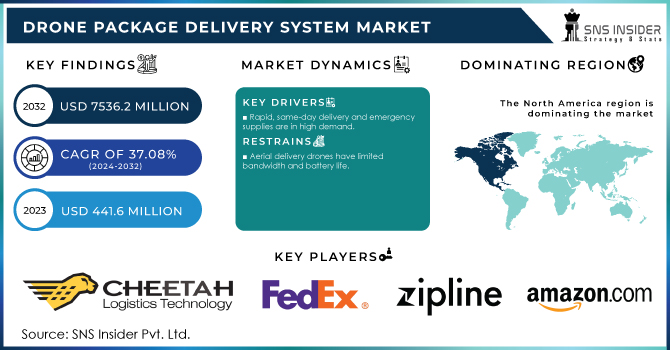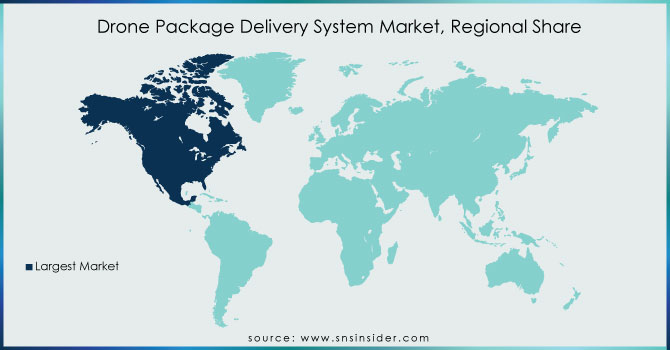Drone Package Delivery System Market Report Scope & Overview:

To get more information on Drone Package Delivery System Market - Request Free Sample Report
The Drone Package Delivery System Market Size was valued at USD 441.6 million in 2023 and is projected to grow to USD 7536.2 million by 2032, with a compound annual growth rate (CAGR) of 37.08% over the forecast period from 2024 to 2032.
A rise in disposable income, which leads to higher living standards, has resulted in an increase in demand for drone package delivery, resulting in the expansion of the Drone Package Delivery Market. Growth in urbanization, which leads to increased demand for drone package delivery in places such as corporate offices and hypermarkets, is another major factor driving the Global Drone Package Delivery Market. The Global Drone Package Delivery Market study offers a comprehensive analysis of the market. The research examines important segments, trends, drivers, restraints, the competitive landscape, and market-significant factors in depth. Artificial intelligence and the internet of things are expected to create new prospects for delivery drones. The growing number of quick service aggregators and restaurants is driving market revenue. The need for this industry is being driven by a small air-frame structure, excellent durability, motion detection, and position tracking. Medicinal personnel increasingly look to these drones to deliver life-saving medical goods on time and at a faster rate. Organizations in the logistics and transportation, retail, agricultural, and healthcare sectors are working to incorporate drone delivery into their business models to ensure the smooth and effective execution of same-day package delivery.
MARKET DYNAMICS
KEY DRIVERS
-
Technological improvements such as VTOL, geospatial mapping, IoT, and machine learning result in improved package delivery accuracy.
-
Rapid, same-day delivery and emergency supplies are in high demand.
RESTRAINTS
-
Aerial delivery drones have limited bandwidth and battery life.
-
Bad weather could stymie drone delivery plans.
OPPORTUNITIES
-
Post-pandemic increase in e-commerce sales and demand for contact-less delivery
-
Development of aerial delivery drones for usage in remote locations
CHALLENGES
-
Consumer acceptability and health concerns related to delivery drone noise
-
Inadequate risk management and insurance coverage for airborne delivery drones
IMPACT OF COVID-19
The global impact of the COVID-19 epidemic has been extraordinary. The ramifications have been far-reaching, notably for aviation. The drone package delivery market is still in its early phases and will be influenced by a variety of issues including drone legislation, consumer adoption, safety, security, and insurance, among others. Drones were experimented with as a delivery alternative by shops such as Amazon and Walmart prior to COVID-19. However, due to airspace limits and worries about drones crossing flight paths, as well as drone laws, customer acceptance, safety, security, and insurance, these drones are still in the pilot project stage.
Following the COVID-19 epidemic, drone technology has emerged as a more prominent, valued asset, as well as one of the safest forms of contactless delivery. During the epidemic, three key use cases of drone technology were discovered: transportation services, aerial spraying, and surveillance and inspection. Delivery drones are reshaping supply networks and enabling socially distant delivery services. As society has begun to perceive that the benefit of drones outweighs possible concerns, the COVID-19 problem is spurring innovation in drone policies.
The drone package delivery industry has been segmented into platform, software, infrastructure, and service. The growing use of delivery drones involves the development of supporting software and infrastructure. Drones, when used with strong logistics software, can significantly boost efficiency. Drone package delivery service companies serve a variety of product delivery applications, including drone food delivery, retail goods delivery, postal delivery, medical equipment delivery, and others. These service providers work in a variety of logistical procedures, including second-party logistics, third-party logistics, and fourth-party logistics.
The drone package delivery platform market is divided into three types fixed-wing, multi-rotor, and hybrid. The hybrid sector is expected to grow at the fastest rate over the projected period. Drone producers all over the world are working on the development of drones for use in package delivery within city limits, as well as the progress of drone technology. Vertical landing and AI-based collision avoidance will expand the market for hybrid drones.
The market is divided into three segments based on end user medical, retail, and others. The medical and healthcare industry dominates the market. Drones have been used in the medical and healthcare sectors to deliver medicines and medical equipment both within and outside of hospital premises. These drones are used for pickups and deliveries in laboratories and pharmacies, increasing labour productivity in hospitals.
The drone package delivery market has been divided into three segments based on operation mode: remotely piloted, partially autonomous, and completely autonomous. Following the success of remotely piloted drones, the industry began to shift to semi autonomous drones, in which the pilot controls only vital operations. All of the activities and operations are identical to those of an autonomous drone, but during flight, it will be constantly or periodically monitored by an operator at the ground station.
KEY MARKET SEGMENTATION
By Type
-
Fixed-Wing
-
Multi-rotor
-
Hybrid
By Range
-
Short <25 Km
-
Long>25 Km
By Duration
-
Short Duration
-
Long Duration
By End Use
-
Medical and Healthcare
-
Retails
-
Others
By Operation Mode
-
Remotely Piloted
-
Partially Autonomous
-
Fully Autonomous
By Solution
-
Platform
-
Infrastructure
-
Software
-
Service
REGIONAL ANALYSIS
The North American drone package delivery market is predicted to grow significantly and at the fastest CAGR over the forecast period. The region's expansion can be ascribed to the growing trend of online buying on e-commerce platforms, as well as favourable FAA regulations in the United States. Many US firms are attempting to commercialize drone package delivery in the region for food, pharmaceutical products, logistics, and retail applications, which will boost to the region's growth throughout the projection period.

Need any customization research on Drone Package Delivery System Market - Enquiry Now
REGIONAL COVERAGE:
-
North America
-
USA
-
Canada
-
Mexico
-
-
Europe
-
Germany
-
UK
-
France
-
Italy
-
Spain
-
The Netherlands
-
Rest of Europe
-
-
Asia-Pacific
-
Japan
-
south Korea
-
China
-
India
-
Australia
-
Rest of Asia-Pacific
-
-
The Middle East & Africa
-
Israel
-
UAE
-
South Africa
-
Rest of Middle East & Africa
-
-
Latin America
-
Brazil
-
Argentina
-
Rest of Latin America
-
KEY PLAYERS
The major Players are Cheetah Logistics Technology, FedEx, Zipline, DHL International GmbH, Drone Scan, BIZZBY, Drone Delivery Canada Corp., Amazon.com Inc., United Parcel Service of America Inc., Boeing and Other Players
| Report Attributes | Details |
|---|---|
| Market Size in 2023 | US$ 441.6 Million |
| Market Size by 2032 | US$ 7536.2 Million |
| CAGR | CAGR of 37.08% From 2024 to 2032 |
| Base Year | 2023 |
| Forecast Period | 2024-2032 |
| Historical Data | 2020-2022 |
| Report Scope & Coverage | Market Size, Segments Analysis, Competitive Landscape, Regional Analysis, DROC & SWOT Analysis, Forecast Outlook |
| Key Segments | • By Type (Fixed-Wing, Multi-rotor, Hybrid) • By Range (Short <25>25 Km), by Duration (Short Duration, Long Duration) • By End Use(Medical and Healthcare, Retails, Others) • By Operation Mode (Remotely Piloted, Partially Autonomous, Fully Autonomous) • By Solution (Platform, Infrastructure, Software, Service) |
| Regional Analysis/Coverage | North America (USA, Canada, Mexico), Europe (Germany, UK, France, Italy, Spain, Netherlands, Rest of Europe), Asia-Pacific (Japan, South Korea, China, India, Australia, Rest of Asia-Pacific), The Middle East & Africa (Israel, UAE, South Africa, Rest of Middle East & Africa), Latin America (Brazil, Argentina, Rest of Latin America) |
| Company Profiles | Cheetah Logistics Technology, FedEx, Zipline, DHL International GmbH, Drone Scan, BIZZBY, Drone Delivery Canada Corp., Amazon.com Inc., United Parcel Service of America Inc., Boeing. |
| KEY DRIVERS | • Technological improvements such as VTOL, geospatial mapping, IoT, and machine learning result in improved package delivery accuracy. • Rapid, same-day delivery and emergency supplies are in high demand. |
| Restraints | • Aerial delivery drones have limited bandwidth and battery life. • Bad weather could stymie drone delivery plans. |

